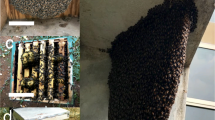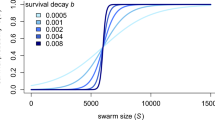Abstract
The last few years have seen a renewed interest in the mechanisms behind nest-site selection in honeybees. Most studies have focused on the cavity-nesting honeybee Apis mellifera, but more recently studies have included the open-nesting A. florea. Amongst species comparisons are important if we want to understand how the process has been adapted over evolutionary time to suit the particular species’ nest-site requirement. Here, we describe the behaviour of scout bees of the giant Asian honeybee A. dorsata on three artificially created swarms to determine the mechanisms used to collectively decide on a location to move to, either in the same environment (nest-site selection) or somewhere further afield (migration). In all swarms, scouts’ dances converged on a general direction prior to lift-off and this direction corresponded to the direction that swarms flew. Scouts from one swarm danced for sites that were far away. These dances did not converge onto a specific distance, implying they were migration dances. Dances for different sites differed in the number of circuits per dance suggesting that A. dorsata scouts make an assessment of site quality. Similarly to A. florea, but in contrast to A. mellifera, A. dorsata scouts did not reduce dance duration after repeated returns from scouting flights. We found that many scouts that dance for a non-preferred location changed dance location during the decision-making process after following dances for the consensus direction. We conclude that the consensus-building process of A. dorsata swarms relies on the interaction of scout bees on the swarm.






Similar content being viewed by others
References
Ahmad R (1989) A note on the migration of Apis dorsata in the Andaman and Nicobar Islands. Bee World 70:62–65
Akratanakul P (1977) The natural history of the dwarf honey bee. PhD, Cornell University, Apis florea F. in Thailand
Britton NF, Franks NR, Pratt SC, Seeley TD (2002) Deciding on a new home: how do honeybees agree? Proc R Soc Lond B 269:1383–1388
Dyer FC (2002) The biology of the dance language. Ann Rev Ent 47:917–949
Dyer FC, Seeley TD (1991) Dance dialects and foraging range in three Asian honey bee species. Behav Ecol Sociobiol 28:227–233
Dyer FC, Seeley TD (1994) Colony migration in the tropical honey bee Apis dorsata F. Insectes Soc 41:129–140
Gronbeck C (1998) Sustainable by design, Seattle, Washington. http://www.susdesign.com/sunangle/
Hepburn HR, Radloff SE (2011) Honeybees of Asia. Springer, Heidelberg
Itioka T et al (2001) Six-year population fluctuation of the Giant honey bee Apis dorsata (Hymenoptera: apidae) in a tropical lowland Dipterocarp forest in Sarawak. Ann Entom Soc Am 94:545–549
Janson S, Middendorf M, Beekman M (2007) Searching for a new home—scouting behavior of honeybee swarms. Behav Ecol 18:384–392
Kahono S, Nakamura K, Amir M (1999) Seasonal migration and colony behavior of the tropical honeybee Apis dorsata F. (Hymenoptera: Apidae). Treubia 31:285–299
Koeniger N, Koeniger G (1980) Observations and experiments on migration and dance communication of Apis dorsata in Sri Lanka. J Api Res 19:21–34
Lindauer M (1955) Schwarmbienen auf Wohnungssuche. Z vergl Physiol 37:263–324
Makinson JC, Oldroyd BP, Schaerf TM, Wattanachaiyingchareon W, Beekman M (2011) Moving home: nest site selection in the Red Dwarf honeybee (Apis florea). Behav Ecol Sociobiol 65:945–958
Makinson JC, Schaerf TM, Rattanawannee A, Oldroyd BP, Beekman M (2014) Consensus building in giant Asian honeybee, Apis dorsata, swarms on the move. Anim Behav 93:191–199
Muscedere ML, Gronenberg W, Moreau CS, Traniello JFA (2014) Investment in higher order central processing regions is not constrained by brain size in social insects. Proc R Soc Lond B 281:20140217
Myerscough MR (2003) Dancing for a decision: a matrix model for nest-site choice by honeybees. Proc R Soc Lond B 270:577–582
Oldroyd BP, Wongsiri S (2006) Asian honey bees. Biology, conservation and human interactions. Harvard University Press, Cambridge, MA
Oldroyd BP, Osborn KE, Mardan M (2000) Colony relatedness in aggregations of Apis dorsata Fabricius (Hymenoptera, Apidae). Insectes Soc 47:94–95
Oldroyd BP, Gloag RS, Even N, Wattanachaiyingcharoen W, Beekman M (2008) Nest-site selection in the open-nesting honey bee Apis florea. Behav Ecol Sociobiol 62:1643–1653
Paar J, Oldroyd BP, Kastberger G (2000) Giant honeybees return to their nest sites. Nature 406:475
Rinderer TE, Wongsiri S, Kuang B, Liu J, Oldroyd BP, Sylvester HA, de Guzman LI (1996) Comparative nest architecture of the dwarf honey bees. J Api Res 35:19–26
Robinson WS (2012) Migrating giant honey bees (Apis dorsata) congregate annually at stopover site in Thailand. PLoS One 7:e44976
Sasaki M, Veeresh GK, Mallik B, Viraktamath CA (1990) Absconding dance in Apis cerana japonica: a slow and long tail-waggling motivates the whole colony to translocate. In: Proceedings of the XIth International Congress of IUSSI, Bangalore, India. pp 125–126
Schaerf TM, Makinson JC, Myerscough MR, Beekman M (2013) Do small swarms have an advantage when house hunting? The effect of swarm size on nest-site selection by Apis mellifera. J R Soc Interface 10:20130533
Schneider SS, McNally LC (1994) Waggle dance behavior associated with seasonal absconding in colonies of the African honey bee Apis mellifera scutellata. Insectes Soc 41:115–127
Seeley TD (2003) Consensus building during nest-site selection in honey bee swarms: the expiration of dissent. Behav Ecol Sociobiol 53:417–424
Seeley TD (2010) Honeybee Democracy. Princeton University Press, Princeton
Seeley TD, Buhrman SC (1999) Group decision making in swarms of honeybees. Behav Ecol Sociobiol 45:19–31
Seeley TD, Buhrman SC (2001) Nest-site selection in honey bees: how well do swarms implement the “best-of-N” decision rule? Behav Ecol Sociobiol 49:416–427
Seeley TD, Morse RA (1978) Nest site selection by the honey bee, Apis mellifera. Insectes Soc 25:323–337
Seeley TD, Tautz J (2001) Worker piping in honey bee swarms and its role in preparing for liftoff. J Comp Phys A 187:667–676
Seeley TD, Visscher PK (2003) Choosing a home: how the scouts in a honey bee swarm perceive the completion of their group decision making. Behav Ecol Sociobiol 54:511–520
Seeley TD, Visscher PK (2004a) Group decision making in nest-site selection by honey bees. Apidol 35:101–116
Seeley TD, Visscher PK (2004b) Quorum sensing during nest-site selection by honeybee swarms. Behav Ecol Sociobiol 56:594–601
Seeley TD, Visscher PK (2008) Sensory coding of nest-site value in honeybee swarms. J Exp Biol 211:3691–3697
Seeley TD, Morse RA, Visscher PK (1979) The natural history of the flight of honey bee swarms. Psyche 86:103–113
Seeley TD, Kleinhenz M, Bujok B, Tautz J (2003) Thorough warm-up before take-off in honey bee swarms. Naturwissensch 90:256–260
Seeley TD, Visscher PK, Schlegel T, Hogan PM, Franks NR, Marshall JAR (2012) Stop signals provide cross inhibition in collective decision making by honeybee swarms. Science 335:108–111
Venkatesh G, Reddy CC (2007) The effect of the availability of bee forage and environmental conditions on the nesting of Apis dorsata Fabr. J Api Res 46:276–281
Villa JD (2004) Swarming behavior of honey bees (Hymenoptera: Apidae) in southeastern Louisiana. Ann Entom Soc Am 97:111–116
Visscher PK, Camazine S (1999) Collective decisions and cognition in bees. Nature 397:400
Wongsiri S, Thapa T, Oldroyd BP, Burgett DM (1996) A magic bee tree: Home to Apis dorsata. Am Bee J 136:796–799
Woyke J, Wilde J, Wilde M (2012) Swarming and migration of Apis dorsata and Apis laboriosa honey bees in India, Nepal and Bhutan. J Api Sc 56:81–91
Acknowledgments
Funding for this project was provided by the Australia-Asia Endeavour Award program (to JCM) and the Australian Research Council (to BPO and MB via DP0878924, DP0984731, MB via FT120100120 and TMS via DP130101670). We thank Dr. Ratna Thapa for providing lab space at Mae Fah Luang University for the duration of this experiment and Professor Siriwat Wongsiri for acting as host. We would also like to thank the Abbot of Wat Pa Mark Nor for allowing us to perform fieldwork on the temple grounds. Tom Seeley and James Marshall provided constructive comments on an earlier version of this manuscript.
Author information
Authors and Affiliations
Corresponding author
Rights and permissions
About this article
Cite this article
Makinson, J.C., Schaerf, T.M., Rattanawannee, A. et al. How does a swarm of the giant Asian honeybee Apis dorsata reach consensus? A study of the individual behaviour of scout bees. Insect. Soc. 63, 395–406 (2016). https://doi.org/10.1007/s00040-016-0482-2
Received:
Revised:
Accepted:
Published:
Issue Date:
DOI: https://doi.org/10.1007/s00040-016-0482-2




